表示方位和方向的介词用法
介词in,on,to 表示方位的用法
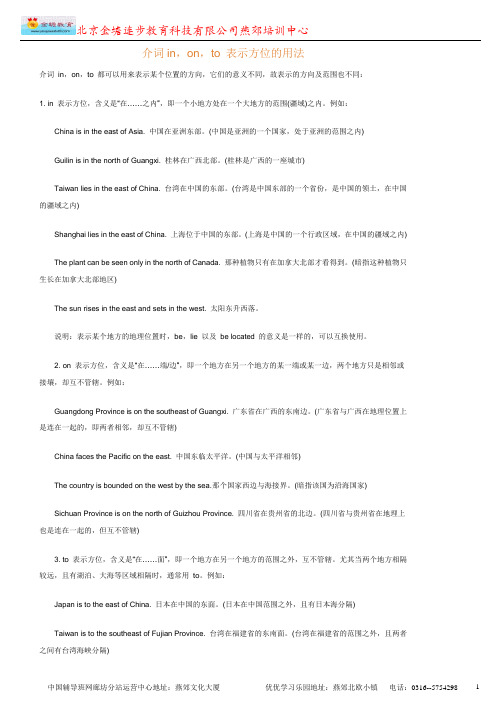
介词in,on,to 表示方位的用法介词in,on,to 都可以用来表示某个位置的方向,它们的意义不同,故表示的方向及范围也不同:1. in 表示方位,含义是“在……之内”,即一个小地方处在一个大地方的范围(疆域)之内。
例如:China is in the east of Asia. 中国在亚洲东部。
(中国是亚洲的一个国家,处于亚洲的范围之内)Guilin is in the north of Guangxi. 桂林在广西北部。
(桂林是广西的一座城市)Taiwan lies in the east of China. 台湾在中国的东部。
(台湾是中国东部的一个省份,是中国的领土,在中国的疆域之内)Shanghai lies in the east of China. 上海位于中国的东部。
(上海是中国的一个行政区域,在中国的疆域之内)The plant can be seen only in the north of Canada. 那种植物只有在加拿大北部才看得到。
(暗指这种植物只生长在加拿大北部地区)The sun rises in the east and sets in the west. 太阳东升西落。
说明:表示某个地方的地理位置时,be,lie 以及be located 的意义是一样的,可以互换使用。
2. on 表示方位,含义是“在……端/边”,即一个地方在另一个地方的某一端或某一边,两个地方只是相邻或接壤,却互不管辖。
例如:Guangdong Province is on the southeast of Guangxi. 广东省在广西的东南边。
(广东省与广西在地理位置上是连在一起的,即两者相邻,却互不管辖)China faces the Pacific on the east. 中国东临太平洋。
(中国与太平洋相邻)The country is bounded on the west by the sea.那个国家西边与海接界。
介词的用法
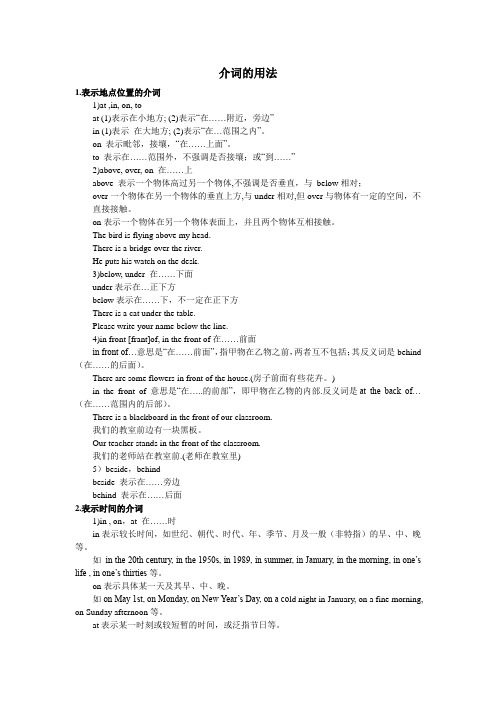
介词的用法1.表示地点位置的介词1)at ,in, on, toat (1)表示在小地方; (2)表示“在……附近,旁边”in (1)表示在大地方; (2)表示“在…范围之内”。
on 表示毗邻,接壤,“在……上面”。
to 表示在……范围外,不强调是否接壤;或“到……”2)above, over, on 在……上above 表示一个物体高过另一个物体,不强调是否垂直,与below相对;over一个物体在另一个物体的垂直上方,与under相对,但over与物体有一定的空间,不直接接触。
on表示一个物体在另一个物体表面上,并且两个物体互相接触。
The bird is flying above my head.There is a bridge over the river.He puts his watch on the desk.3)below, under 在……下面under表示在…正下方below表示在……下,不一定在正下方There is a cat under the table.Please write your name below the line.4)in front [frant]of, in the front of在……前面in front of…意思是“在……前面”,指甲物在乙物之前,两者互不包括;其反义词是behind (在……的后面)。
There are some flowers in front of the house.(房子前面有些花卉。
)in the front of 意思是“在…..的前部”,即甲物在乙物的内部.反义词是at the back of…(在……范围内的后部)。
There is a blackboard in the front of our classroom.我们的教室前边有一块黑板。
Our teacher stands in the front of the classroom.我们的老师站在教室前.(老师在教室里)5)beside,behindbeside 表示在……旁边behind 表示在……后面2.表示时间的介词1)in , on,at 在……时in表示较长时间,如世纪、朝代、时代、年、季节、月及一般(非特指)的早、中、晚等。
表示方位的英语介词
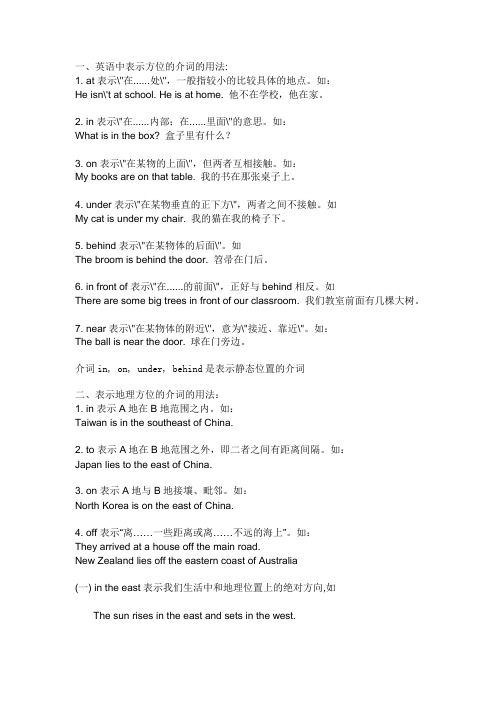
一、英语中表示方位的介词的用法:1. at表示\"在......处\",一般指较小的比较具体的地点。
如:He isn\'t at school. He is at home. 他不在学校,他在家。
2. in表示\"在......内部;在......里面\"的意思。
如:What is in the box? 盒子里有什么?3. on表示\"在某物的上面\",但两者互相接触。
如:My books are on that table. 我的书在那张桌子上。
4. under表示\"在某物垂直的正下方\",两者之间不接触。
如My cat is under my chair. 我的猫在我的椅子下。
5. behind表示\"在某物体的后面\"。
如The broom is behind the door. 笤帚在门后。
6. in front of表示\"在......的前面\",正好与behind相反。
如There are some big trees in front of our classroom. 我们教室前面有几棵大树。
7. near表示\"在某物体的附近\",意为\"接近、靠近\"。
如:The ball is near the door. 球在门旁边。
介词in, on, under, behind是表示静态位置的介词二、表示地理方位的介词的用法:1. in表示A地在B地范围之内。
如:Taiwan is in the southeast of China.2. to表示A地在B地范围之外,即二者之间有距离间隔。
如:Japan lies to the east of China.3. on表示A地与B地接壤、毗邻。
如:North Korea is on the east of China.4. off表示“离……一些距离或离……不远的海上”。
表示方位的英语介词
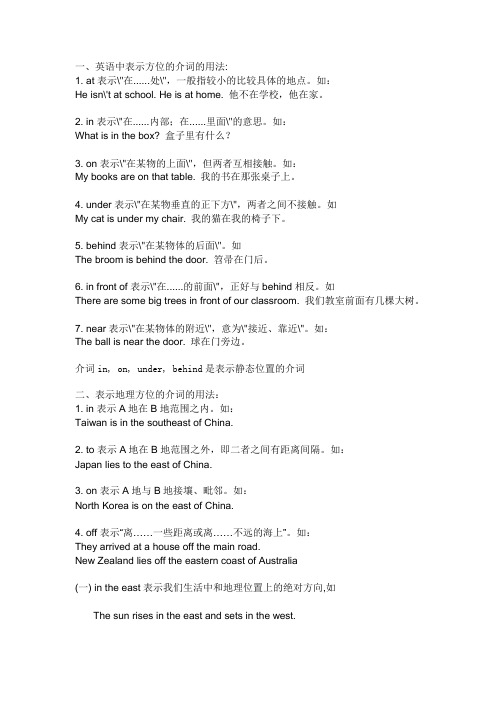
一、英语中表示方位的介词的用法:1. at表示\"在......处\",一般指较小的比较具体的地点。
如:He isn\'t at school. He is at home. 他不在学校,他在家。
2. in表示\"在......内部;在......里面\"的意思。
如:What is in the box? 盒子里有什么?3. on表示\"在某物的上面\",但两者互相接触。
如:My books are on that table. 我的书在那张桌子上。
4. under表示\"在某物垂直的正下方\",两者之间不接触。
如My cat is under my chair. 我的猫在我的椅子下。
5. behind表示\"在某物体的后面\"。
如The broom is behind the door. 笤帚在门后。
6. in front of表示\"在......的前面\",正好与behind相反。
如There are some big trees in front of our classroom. 我们教室前面有几棵大树。
7. near表示\"在某物体的附近\",意为\"接近、靠近\"。
如:The ball is near the door. 球在门旁边。
介词in, on, under, behind是表示静态位置的介词二、表示地理方位的介词的用法:1. in表示A地在B地范围之内。
如:Taiwan is in the southeast of China.2. to表示A地在B地范围之外,即二者之间有距离间隔。
如:Japan lies to the east of China.3. on表示A地与B地接壤、毗邻。
如:North Korea is on the east of China.4. off表示“离……一些距离或离……不远的海上”。
表示方位的英语介词

一、英语中表示方位的介词的用法:1. at表示\"在......处\",一般指较小的比较具体的地点。
如:He isn\'t at school. He is at home. 他不在学校,他在家。
2. in表示\"在......内部;在......里面\"的意思。
如:What is in the box? 盒子里有什么?3. on表示\"在某物的上面\",但两者互相接触。
如:My books are on that table. 我的书在那张桌子上。
4. under表示\"在某物垂直的正下方\",两者之间不接触。
如My cat is under my chair. 我的猫在我的椅子下。
5. behind表示\"在某物体的后面\"。
如The broom is behind the door. 笤帚在门后。
6. in front of表示\"在......的前面\",正好与behind相反。
如There are some big trees in front of our classroom. 我们教室前面有几棵大树。
7. near表示\"在某物体的附近\",意为\"接近、靠近\"。
如:The ball is near the door. 球在门旁边。
介词in, on, under, behind是表示静态位置的介词二、表示地理方位的介词的用法:1. in表示A地在B地范围之内。
如:Taiwan is in the southeast of China.2. to表示A地在B地范围之外,即二者之间有距离间隔。
如:Japan lies to the east of China.3. on表示A地与B地接壤、毗邻。
如:North Korea is on the east of China.4. off表示“离……一些距离或离……不远的海上”。
介词短语和位置如何用介词短语来表示位置

介词短语和位置如何用介词短语来表示位置介词短语和位置:如何用介词短语来表示位置位置是我们在日常生活中经常需要表达的概念之一,而介词短语是为了准确描述位置而被广泛使用的一种语言形式。
在本文中,我们将探讨介词短语在表达位置方面的应用以及其使用方法。
一、概述介词短语是由介词和宾语组成的短语,而介词则用来表示人或事物在空间或时间上的关系。
介词短语在表达位置时,不仅提供了方向和位置信息,同时还能进行更具体的描述,有效地增强了表达的准确性。
二、位置方位介词短语1. 在涉及描述位置的情况下,最常见的位置方位介词短语包括:“在……上方”、“在……下方”、“在……前方”、“在……后方”等。
例如,我们可以说:“书架上方放着一本红色的书。
”、“花瓶下方摆着一束鲜花。
”这样,我们清晰地描述了物体相对于其他物体的位置。
2. 另外,还有一些特殊的位置方位介词短语,如:“在……左边”、“在……右边”等。
这些介词短语常用于描述人或物体在平面上的位置。
例如:“大门左边有一棵大树。
”、“桌子右边有一台电脑。
”通过这些描述,我们能够更准确地指示出人或者物体所在的具体位置。
三、描述位置的其他介词短语1. 除了位置方位介词短语外,还有其他的介词短语可以用来描述位置。
比如,“在……中间”、“在……周围”等,它们提供了更灵活的描述方式。
例如:“小孩子们手拉手站在花圃中间。
”、“公园周围环绕着高楼大厦。
”通过使用这些介词短语,我们可以更具细节地表达位置的信息。
2. 此外,还可以使用一些介词短语来描述位置的相对关系,如:“在……附近”、“在……远处”等。
这样的描述关注的是物体或人与某一点之间的距离和位置关系。
例如:“超市附近有一家咖啡店。
”、“山的远处有一片蓝蓝的海。
”这样,我们可以很好地描述出事物之间的位置关系。
四、注意事项1. 在使用介词短语表达位置时,要注意准确描述目标物体或人所处的位置,避免产生歧义或误解。
2. 介词短语的使用要考虑语境,根据具体情况选择合适的介词,以确保表达的准确性。
方位介词的用法和区别

表示方位的名词east(东),west(西), south(南), north(北)等前面都能用表示方位的介词in, on和to,那么这三个介词的用法有什么区别呢?下面就让我详细讲解给大家:
I. "in the+方位名词"指的是小范围在一个大范围的里面,表示"在某范围之内",强调两者的包含关系。
如:
Beijing is in the north of China. 北京在中国的北部。
II. "on the+方位名词"指的是一个范围紧挨着另一个范围,表示"两地接壤",强调两者为相邻关系。
如:
Korea is on the northeast of China. 朝鲜在中国的东北面。
III. "to the+方位名词"指的是一个范围和另一个范围之间隔段距离,表示"在某范围之外",强调两者是远离关系。
如:
Japan is to the east of China. 日本位于中国的东边。
方位介词
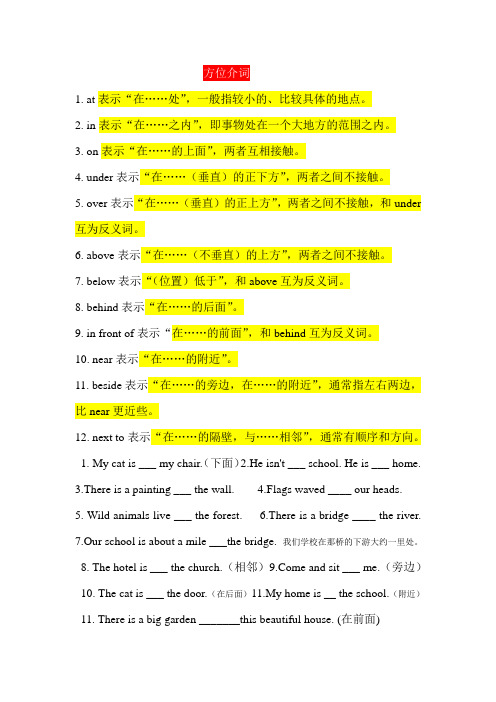
1. at表示“在……处”,一般指较小的、比较具体的地点。
2. in表示“在……之内”,即事物处在一个大地方的范围之内。
3. on表示“在……的上面”,两者互相接触。
4. under表示“在……(垂直)的正下方”,两者之间不接触。
5. over表示“在……(垂直)的正上方”,两者之间不接触,和under 互为反义词。
6. above表示“在……(不垂直)的上方”,两者之间不接触。
7. below表示“(位置)低于”,和above互为反义词。
8. behind表示“在……的后面”。
9. in front of表示“在……的前面”,和behind互为反义词。
10. near表示“在……的附近”。
11. beside表示“在……的旁边,在……的附近”,通常指左右两边,比near更近些。
12. next to表示“在……的隔壁,与……相邻”,通常有顺序和方向。
1. My cat is ___ my chair.(下面)2.He isn't ___ school. He is ___ home.3.There is a painting ___ the wall.4.Flags waved ____ our heads.5. Wild animals live ___ the forest.6.There is a bridge ____ the river.7.Our school is about a mile ___the bridge. 我们学校在那桥的下游大约一里处。
8. The hotel is ___ the church.(相邻)e and sit ___ me.(旁边)10. The cat is ___ the door.(在后面)11.My home is __ the school.(附近)11. There is a big garden _______this beautiful house. (在前面)。
表示方位的介词英语
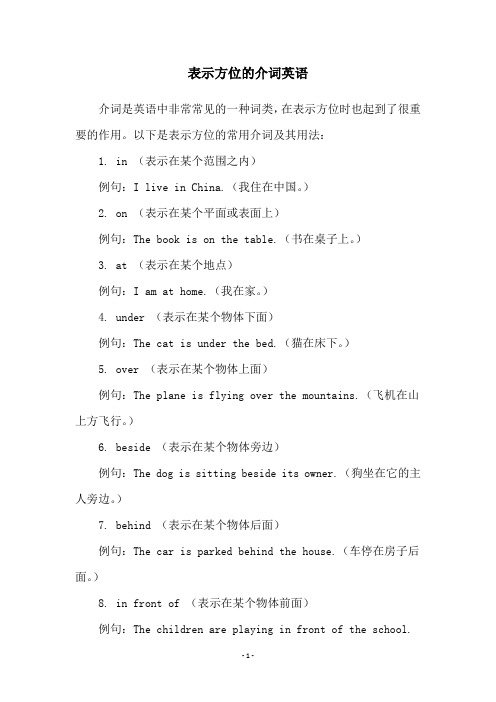
表示方位的介词英语
介词是英语中非常常见的一种词类,在表示方位时也起到了很重要的作用。
以下是表示方位的常用介词及其用法:
1. in (表示在某个范围之内)
例句:I live in China.(我住在中国。
)
2. on (表示在某个平面或表面上)
例句:The book is on the table.(书在桌子上。
)
3. at (表示在某个地点)
例句:I am at home.(我在家。
)
4. under (表示在某个物体下面)
例句:The cat is under the bed.(猫在床下。
)
5. over (表示在某个物体上面)
例句:The plane is flying over the mountains.(飞机在山上方飞行。
)
6. beside (表示在某个物体旁边)
例句:The dog is sitting beside its owner.(狗坐在它的主人旁边。
)
7. behind (表示在某个物体后面)
例句:The car is parked behind the house.(车停在房子后面。
)
8. in front of (表示在某个物体前面)
例句:The children are playing in front of the school.
(孩子们在学校前玩耍。
)
以上是表示方位的介词英语,希望对大家有所帮助!。
方位介词 英语
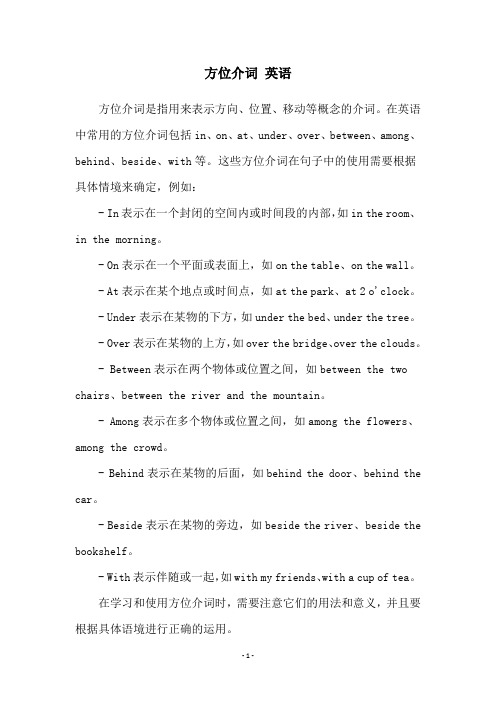
方位介词英语
方位介词是指用来表示方向、位置、移动等概念的介词。
在英语中常用的方位介词包括in、on、at、under、over、between、among、behind、beside、with等。
这些方位介词在句子中的使用需要根据具体情境来确定,例如:
- In表示在一个封闭的空间内或时间段的内部,如in the room、in the morning。
- On表示在一个平面或表面上,如on the table、on the wall。
- At表示在某个地点或时间点,如at the park、at 2 o'clock。
- Under表示在某物的下方,如under the bed、under the tree。
- Over表示在某物的上方,如over the bridge、over the clouds。
- Between表示在两个物体或位置之间,如between the two chairs、between the river and the mountain。
- Among表示在多个物体或位置之间,如among the flowers、among the crowd。
- Behind表示在某物的后面,如behind the door、behind the car。
- Beside表示在某物的旁边,如beside the river、beside the bookshelf。
- With表示伴随或一起,如with my friends、with a cup of tea。
在学习和使用方位介词时,需要注意它们的用法和意义,并且要根据具体语境进行正确的运用。
介词in,on,to,off-方位-表达法解读

There is a beautiful park to the east of the station.
比较下列句子
1.The church is located to the south of the city. 那座教堂在本市的南面。 (该教堂在本市范围之外) 2.The church is located in the south of the city. 那座教堂在本市的南部。
莉莉住在公园大道附近的一套公寓里。
3.The house stands miles off the main road. 那所房子离大路好几英里远。
仿句练习
1.王妃的起居室挨着客厅。
The Princess's sitting-room is off the drawing room.
2.古巴离美国沿海仅九十英里。 Cuba is ninety miles off the coast of the United States. 3.这家饭店就在主干道旁边。 The restaurant is just off the main road.
仿句练习
1.上海位于中国的东部。 Shanghai lies in the east of China. 2.那种植物只有在加拿大北部才看得到。 The plant can be seen only in the north of Canada. (暗指这种植物只生长在加拿大北部地区) 3.北京在中国的北部。 Beijing is in the north of China.
THANKS
(暗指该国为沿海国家)
三.介词to表方位用法1 “to the+方位名词”,表示“在某范围之外”,强调两者是远离 关系,互不管辖。尤其当两个地方相隔较远,且有湖泊、大海 等区域相隔时,通常用 to。 eg. 1.Japan is to the east of China. 日本在中国分隔)
英语东南西北方位介词用法大全
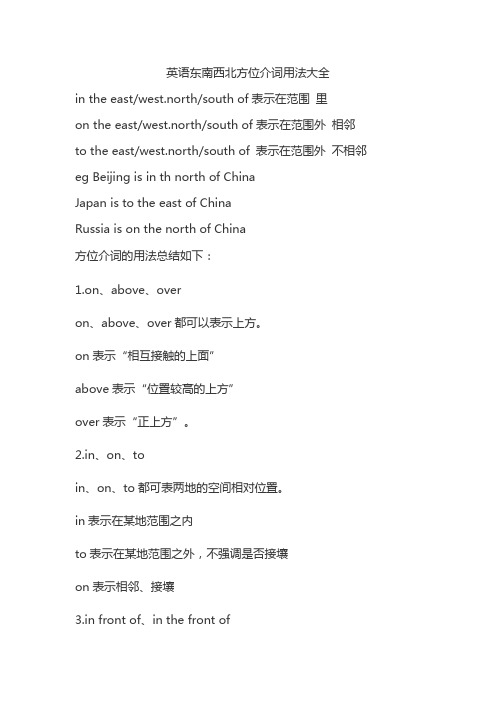
英语东南西北方位介词用法大全
in the east/west.north/south of表示在范围里
on the east/west.north/south of表示在范围外相邻to the east/west.north/south of 表示在范围外不相邻eg Beijing is in th north of China
Japan is to the east of China
Russia is on the north of China
方位介词的用法总结如下:
1.on、above、over
on、above、over都可以表示上方。
on表示“相互接触的上面”
above表示“位置较高的上方”
over表示“正上方”。
2.in、on、to
in、on、to都可表两地的空间相对位置。
in表示在某地范围之内
to表示在某地范围之外,不强调是否接壤
on表示相邻、接壤
3.in front of、in the front of
in front of表示“在......外部的前面”
in the front of表示“在......内部的前面”。
4.near、by、beside
near表示“在附近”
by和beside表示“在旁边”,比near表示的距离更近一些。
5.between、among
between表示“在二者之间”
among表示“在多者之间”。
需要注意的是,among通常后接抽象的人和事物,若需接具体的人和事物时,即使表示多者之间,也应当用between,此时可以理解为多者之中的任意二者之间。
介 词 的 种 类 及 用 法四:表示地点及方位under near around between opposite across through past
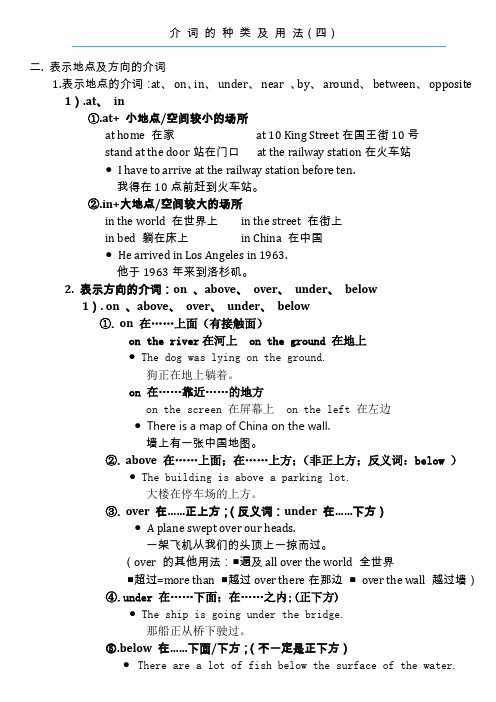
介词的种类及用法(四)二. 表示地点及方向的介词1.表示地点的介词:at、on、in、under、near 、by、around、between、opposite1).at、in①.at+ 小地点/空间较小的场所at home 在家at 10 King Street在国王街10号stand at the door站在门口at the railway station在火车站●I have to arrive at the railway station before ten.我得在10点前赶到火车站。
②.in+大地点/空间较大的场所in the world 在世界上in the street 在街上in bed 躺在床上in China 在中国●He arrived in Los Angeles in 1963.他于1963年来到洛杉矶。
2. 表示方向的介词:on 、above、over、under、below1). on 、above、over、under、below①. on在……上面(有接触面)on the river在河上 on the ground 在地上●The dog was lying on the ground.狗正在地上躺着。
on 在……靠近……的地方on the screen 在屏幕上 on the left 在左边●There is a map of China on the wall.墙上有一张中国地图。
②. above在……上面;在……上方;(非正上方;反义词:below )●The building is above a parking lot.大楼在停车场的上方。
③. over 在……正上方;(反义词:under 在……下方)●A plane swept over our heads.一架飞机从我们的头顶上一掠而过。
(over 的其他用法:■遍及all over the world 全世界■超过=more than ■越过over there在那边■over the wall 越过墙)④.under 在……下面;在……之内;(正下方)●The ship is going under the bridge.那船正从桥下驶过。
方位介词的用法总结

方位介词的用法总结
方位介词是指表示“位置、方向、距离”等方面的介词,在英语中常用的有on, in, at, up, down, to等。
这些介词不仅在语法中具有重要地位,也在交际中是不可或缺的。
在这里,我们来总结一下方位介词的用法。
1. On
On是一个常用的方位介词,表示在某个平面或表面上。
例如:on the table(在桌子上)、on the wall(在墙上)、on the floor(在地板上)等。
2. In
3. At
At表示一个准确的点或位置。
例如:at the bus station(在汽车站)、at the front door(在前门)等。
4. Up
Up表示朝上的方向。
例如:look up(向上看)、climb up(爬上)等。
5. Down
Down表示朝下的方向。
例如:fall down(摔倒)、go down(下降)等。
6. To
总之,方位介词在英语中的使用是非常广泛的,了解这些介词的用法,可以更清楚地表达自己的意思。
介词的用法总结大全

介词的用法总结大全介词是连接名词、代词、动词或介词短语等的词,表示它们之间的关系。
下面是介词的用法总结:1.表示位置或方向:- in(在...里面):in the box(在盒子里)- on(在...上面):on the table(在桌子上)- at(在...处):at the park(在公园)2.表示时间:- in(在...之前或之后一段时间):in the morning(早上)- on(在...的具体日期或其中一天):on Monday(星期一)- at(在其中一具体时刻):at 3 o'clock(在3点钟)3.表示原因或目的:- for(为了):I study hard for my future(为了我的未来,我努力学习)4.表示方式或手段:- by(用,由):I go to work by bus(我坐公交车去上班)- with(用,带有):He writes with a pen(他用钢笔写)5.表示比较:- than(比):He is taller than me(他比我高)- as(与...一样):He is as tall as me(他和我一样高)6.表示所属关系:- of(属于):the book of Peter(彼得的书)7.表示方法或手法:- in(用):write in pencil(用铅笔写)8.表示目的地或方位:- to(到):go to school(去学校)- towards(朝向):walk towards the river(朝河边走)9.表示条件:- if(如果):If it rains, we won't go out(如果下雨,我们就不会出去)10.表示比较:- like(像):He looks like his father(他长得像他父亲)11.表示由其中一种材料:- with(用):a bag made with leather(由皮革制成的包)12.表示途经或经过:- through(通过):go through the forest(穿过森林)13.表示对比或对立:- against(对抗):fight against the enemy(与敌人作战)14.表示关系或连接:- with(和):talk with friends(和朋友谈话)。
古文中方位名词作介词的例句
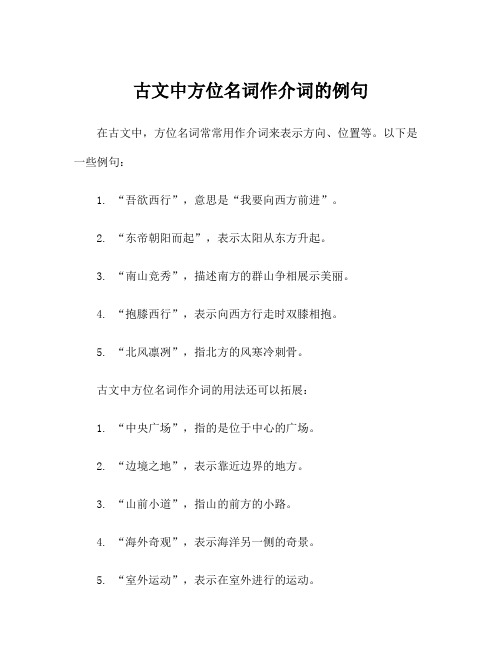
古文中方位名词作介词的例句在古文中,方位名词常常用作介词来表示方向、位置等。
以下是一些例句:
1. “吾欲西行”,意思是“我要向西方前进”。
2. “东帝朝阳而起”,表示太阳从东方升起。
3. “南山竞秀”,描述南方的群山争相展示美丽。
4. “抱膝西行”,表示向西方行走时双膝相抱。
5. “北风凛冽”,指北方的风寒冷刺骨。
古文中方位名词作介词的用法还可以拓展:
1. “中央广场”,指的是位于中心的广场。
2. “边境之地”,表示靠近边界的地方。
3. “山前小道”,指山的前方的小路。
4. “海外奇观”,表示海洋另一侧的奇景。
5. “室外运动”,表示在室外进行的运动。
这些例句和拓展都展示了古文中方位名词作介词的用法,强调了方向、位置以及相对关系。
- 1、下载文档前请自行甄别文档内容的完整性,平台不提供额外的编辑、内容补充、找答案等附加服务。
- 2、"仅部分预览"的文档,不可在线预览部分如存在完整性等问题,可反馈申请退款(可完整预览的文档不适用该条件!)。
- 3、如文档侵犯您的权益,请联系客服反馈,我们会尽快为您处理(人工客服工作时间:9:00-18:30)。
表示方位和方向的介词用法
表示位置的介词有:at, in, by, near, between, under
表示方向的介词有: to, into, out, out of, across, along, through
1 at表示在某地点,强调在某个位置点例:I met her at the school gate this morning. 我今天早上在校门口遇见了她。
at也用于街道号码前例:She lives at 78 Nanjing Road. 她住在南京路78号。
She lives on Nanjing Road. 她住在南京路。
(街道前无号码时用on)She lives in Queen Street. 她住在女王街。
(住在某大街用in)
2 in表示“在某区域内,在一个空间的内部,在……里面”
例:She was born in Nanjing. 她生于南京。
提示:两个地名连用时,小的用at,大的
用in.例:He arrived at London in England last week. 他上周到达英国伦敦。
They
will meet at Washington in America. 他们将在美国华盛顿会面。
3 on表示“在……上”,并与之相接触
例:He put the dictionary on the desk. 他把词典放在桌子上。
比较英国英语和美国英语的不同介词用法:在路上 on the road (美)in the road (英)在街上 on the street (美)in the street (英)在周末 on the weekend (美)at the weekend (英)在这个队 on the team (美)in the team (英)
4 under和below表示“在……的正下方”,指垂直上下。
below表示“低于某物”,只表示位置低于,但不是在正下方。
例:There is a chair under the table. 桌子下面有一
把椅子。
(垂直)He saw many hills and rivers below the plane. 他看见飞机的下方
有许多小山和河流。
5 over和under 表示“在……垂直的上方”,与under相对;above表示“在……的上方”,指高于某物,但不是正上方,与below相对。
例: He is holding an umbrella over his head. 他撑着一把伞遮头。
An airplane flew above the clouds. 一架飞
机在云端上面飞行。
(云层的上面)
6 between,between 表示“在……之间”,一般用于两者之间.例:He sat between Jack and Lily. 他坐在杰克和莉莉中间。
I'm usually free between Tuesday and Friday.
我通常星期二至星期五有空。
7 among 表示“在……中间”,一般用于三者或三者以上之间例:She took a seat among the children. 她在孩子们中间坐了下来。
提示强调三者以上每两两这间也要用between例: There are some differences between the three of them. 他们三者之
间有一些差别。
8 behind和in front of, behind 表示“在……后面”,in front of表示“在……前面,在……前部”,两者均表示静态的位置.例:There is an apple tree behind the house.
房子后面有一棵苹果树。
There is a garden in front of my window. 我的窗前有一个
花园。
He could hardly see the road in front of him. 他几乎看不见前面的路。
9 After和before表示“在……后面”,表示动态的位置,也表示次序;before表示“在……前面”,可表示动态或静态的位置。
例:Spring comes after winter. 冬去
春来。
The policed are after him. 警察在追捕他。
He sat before me. 他坐在我前面。
She got to the office before others. 她比别人先到办公室。
10 by, beside, by和beside均表示“在……旁边”,常可换用
例: The hotel is beside (/by) the river. 那家饭店在河边。
Come and sit beside (/by) me. 过来,坐在我边上。
11 near和next to,near表示“在……附近”,表示的距离比by和beside稍远些,也
时常换用.例:There is a theatre near his home. 他家附近有一家剧院。
next to表示“紧靠……的旁边”
例:The new building next to the bookstore is a cinema. 书店旁边的那幢新楼是一
家电影院。
12 in, into和out of
in表示“在……内”,常指静态
例:There are six pencils in the box. 盒子里有6支铅笔。
into表示“进入”,指由外到内,指动态,常同walk, run, fly, go, come等连用
例: He jumped into the river. 他跳进了河里。
out of 表示“从……里面向外”,指动态,反义词是into,例:She looked out of the window. 她向窗外望去。
The man rushed out of the room. 那人冲出了房间。
13 on 和 onto
on表示“在……上”,指在表面上
例:There is a lamp on the table. 桌上有一盏灯。
onto表示“到……上面”,常同移动意义的动词连用,如:jump, climb, lift等
例:The boy jumped onto the floor. 这男孩跳到地板上。
14 from表示“距离,分离”,指离开某个点
例:The town is not far from my home. 那座小城离我家不远。
15 off表示“和……分离,自……下来”;指脱离一个面或一条线
例:He was thrown off the horse. 他从马背上摔下来。
The old man suddenly fell off the bike. 那位老人突然从自行车上摔了下来。
16 across表示“横过”,指横穿过一平面和一条线
例:He walked across the road carefully. 他小心地过马路。
17 through 表示“穿过”,指从某个空间或地区内穿过,从这端进入从那端出来
例:The path goes through the forest. 这条小路穿过森林。
He left through the back door.他从后门离开的。
18 to表示“到……目的地”,强调到达目的地
例:She took the children to an animal park. 她把孩子们带到一个动物园。
19 towards表示“向……方向”,指方向,不包含到达目的地的概念
例:He was walking towards the hospital when I met him. 我遇到他时,他正向医院那边走。
例:John drove towards Shanghai. 约翰开车往上海方向去。
John drove to Shanghai.约翰开车去了上海。
20 for表示“向……,往……”,常同leave, start, set out等连用
例:They started for the top of the mountain early in the morning. 他们一大早就朝山顶出发。
We shall set out for Africa soon. 我们不久将出发去非洲。
21 round和 around表示“周围”。
例:The students stood round(/around) the teacher. 学生们站在老师周围。
He traveled around(/round) the world. 他周游了世界。
22 about表示“各处,到处”,指范围较模糊的“附近”例:He is walking about the town. 他在城里到处走走。
23 along表示“沿着,顺着”例:They had a long walk along the river. 他们沿着河走了很长的路。
